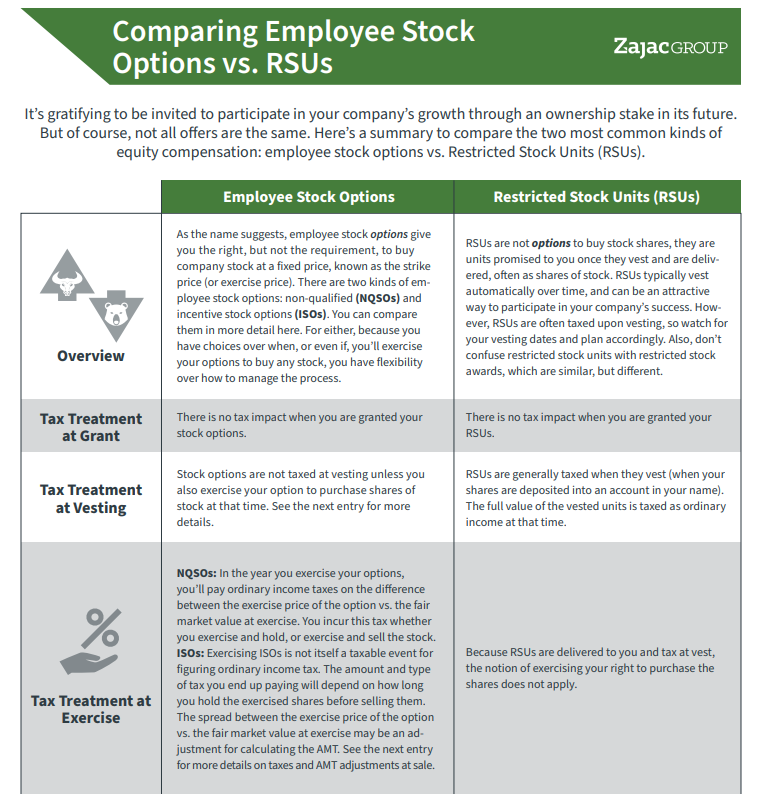
When you exercise your employee stock options, you may want to consider one of the following options to implement the exercise:
This is not an exhaustive list of options. You may run across other terms such as sell-to-cover, same-day sale, or share withholding. While some of these terms are interchangeable and result in a similar outcome, you should check your plan details prior to implementing any specific exercise strategy.
Knowing your options may be easy. Evaluating whether to employ a cash vs. cashless exercise of your employee stock options may be more difficult.
For starters, the math behind what happens during a cash or a cashless exercise be tricky. And your decision to exercise will likely impact your cash flow, your investment risk profile, and how many shares of stock you will hold after the exercise of your employee stock options is complete.
If you find yourself holding employee stock options, you should know what a cash exercise and a cashless exercise are. You should also educate yourself on the details of a sell to cover, a same-day sale, and a share withholding. Each one has its own advantages and disadvantages to consider.
It’s possible that a large portion of your net worth is tied up in company stock options, so you owe it to yourself to evaluate and execute a strategy that maximizes your value (within your stated goals).
Not All Stock Offers are the Same! Here's a helpful comparison between two of the most common employee stock options.

If your goal is to own as many shares of the employee stock as possible post-exercise, a cash exercise may be the best option. The process of a cash exercise may entail the following:
Depending on the number of vested options you can exercise and the strike price at which you can exercise them, the out-of-pocket cost of a cash exercise can be a big number.
Unfortunately, it’s not uncommon to not have the necessary cash available to fund a cash exercise, or a preference to not use cash to pay for the exercise. For this reason, many find themselves “priced out” of a cash exercise, forcing them into a cashless exercise.
If you are one of those with cash on hand, here are a few things to know before you do a cash exercise:
Typically, those who choose a cash exercise are optimistic that the value of the company stock will go up. Therefore, they plan to hold the company stock in the medium- and long term. By holding company stock, you expose your portfolio to both the upside and downside risk of the markets.
Generally speaking, if the stock price goes up, you win. If the stock price goes down, you lose.
If the goal is to retain no shares or some shares post-exercise, but not all shares, then some sort of a cashless exercise may be a good alternative strategy. A cashless exercise is often the default option if you don’t have the cash to pay the cost readily available.
A few highlights of a cashless exercise:
A cashless exercise can be designed to cover only the exercise cost of the shares for which you need to purchase, the tax liability you will incur on the exercise of your shares, or both. The choice of how many shares you wish to buy and hold and how many shares to buy and sell might depend on the exercise price of your option and the current fair market price of the stock.
Now that you understand some of those details, let’s take a moment to understand what this all means:
In a simple form, the decision on whether to do a cash or a cash exercise may boil down to whether or not you have enough cash on hand to cover the cost of an exercise and hold?
If you said yes, then ask this follow-up question: Do you want to use that cash to buy and hold shares of company stock?
If the answer is “yes” again, a cash exercise may be a strategy to maximize your company stock holding. If you answered “no” to both questions or to the second, you might consider a cashless exercise.
That being said, your decision shouldn’t be based only on whether or not you have the cash to buy the shares. The decision should be made with consideration of how many shares of stock you want to hold, how close you are to retirement (or other financial goals), and your overall attitude towards investment risk.
Once you balance these answers against your ability to do a cash exercise or not, you can begin to determine what the best exercise strategy may be.
This material is intended for informational/educational purposes only and should not be construed as investment, tax, or legal advice, a solicitation, or a recommendation to buy or sell any security or investment product. Hypothetical examples contained herein are for illustrative purposes only and do not reflect, nor attempt to predict, the actual results of any investment. The information contained herein is taken from sources believed to be reliable, however, accuracy or completeness cannot be guaranteed. Please contact your financial, tax, and legal professionals for more information specific to your situation. Investments are subject to risk, including the loss of principal. Because investment return and principal value fluctuate, shares may be worth more or less than their original value. Some investments are not suitable for all investors, and there is no guarantee that any investing goal will be met. Past performance is no guarantee of future results. Talk to your financial advisor before making any investing decisions.
Whether you’re just getting started or expanding your knowledge, here are some resources to get you started.
Glossary
ESOs vs RSUs
All Things Incentive Stock Options